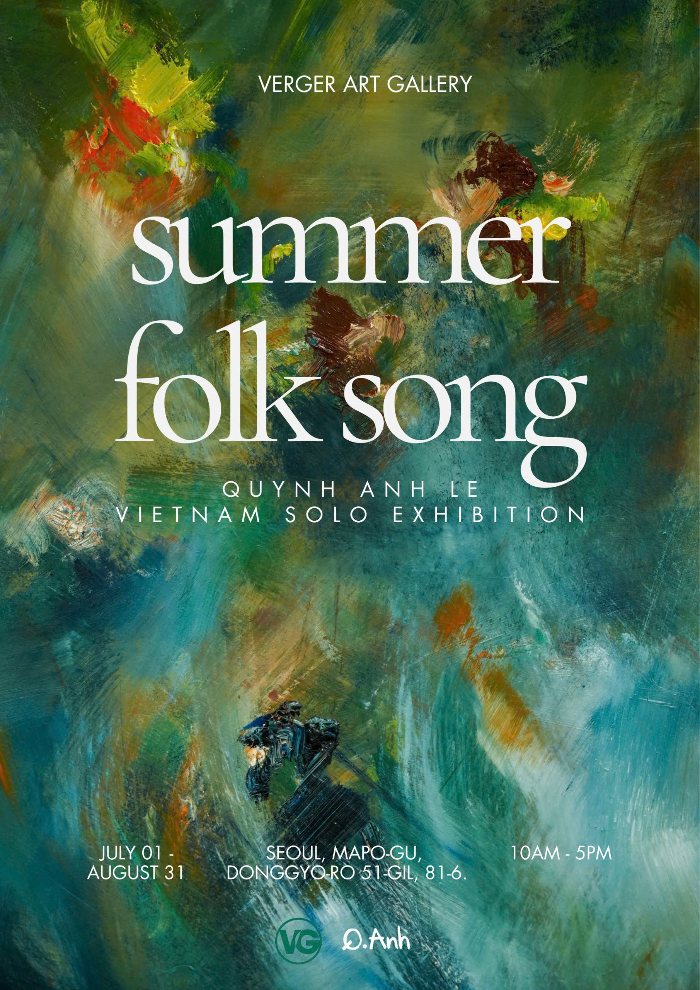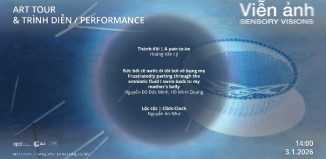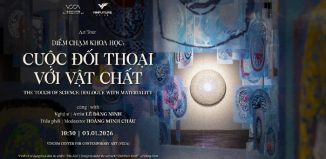Exhibition “A Summer Folk Song”

Opening: 03 pm – 07 pm, Tues 01 July 2025
Exhibition: 01 July – 31 Aug 2025
Berge Art Gallery
B1st floor 51-gil 81-6, Mapo-gu, Seoul
From the organizer:
“Beauty is owed to duration, to contemplative synopsis. It is not a momentous brilliance or attraction, but an afterglow, a phosphorescence of things… Only in lingering contemplation, even an ascetic restraint, do things unveil their beauty, their fragrant essence.”
— Han Byung-Chul, The scent of time: a philosophical essay on the art of lingering
Lê Quỳnh Anh’s paintings in A Summer Folk Song unfold a transient realm of distance, of visual silence. She does not depict nature realistically; instead, she distills it into patches of color, lines, and textures, as if carefully preserving each nuance of memory. This approach allows the viewer not only to see the scenery but also to sense its rhythm, temperature, and even the scent of space. In Fading Horizon, thin layers of paint overlap to create a soft glow of light, like the golden rays of dusk dissolving upon a lake’s surface. In contrast, Hidden in the Wind evokes the graceful sway of small trees rustling in a gentle breeze, with brushstrokes as free as calligraphy—both bold and delicate.
In A Summer Folk Song at Verger Gallery, Seoul, the contrast between the frenetic urban rhythm of Korea and the tranquil countryside of Vietnam is rendered through an abstract language—a quiet reminder of a harmony with nature that people are gradually losing. It is a subtle resistance to the relentless visual tempo of urban life, like that of Seoul, which fragments time into a disjointed sequence of fleeting, ostentatious, and forgettable moments. For a folk song, much like the scent Han Byung-Chul speaks of in his renowned philosophical work, belongs to slowness—to things lived through recollection and memory, unhurried, distilled, and enduring. And so, it escapes action and immediate enjoyment. These paintings demand pause and time. Immersing oneself in Floating Clouds, Still Water or A Passing Thought, one experiences something akin to sensory remembrance—as though the landscapes have lost their distinct forms yet retain their essence, an atmosphere full of care and tenderness. Nature, though not directly depicted, remains at the heart of each work: both the material of formation and the space nurturing a way of feeling alive.
Nearly a century has passed since Alfred Barr—the first director of MoMA (New York)—theorized abstraction, yet interpretations of nature’s reflection and humanity’s relationship with it have since taken on new, contemporary experimental dimensions. Abstraction in Quỳnh Anh’s work is not a departure from reality but another way of grasping its essence. Like a folk song that does not narrate a specific story but contains within it an entire world of emotion, her paintings hold deep, layered meanings, requiring the viewer to pause, contemplate, and feel with the heart. And perhaps, in an increasingly hurried world, we need artists like Lê Quỳnh Anh—those who know how to preserve the scents of memory, the folk songs of their own.
— Nguyễn Tú Hằng
Some artworks at the exhibition:




















